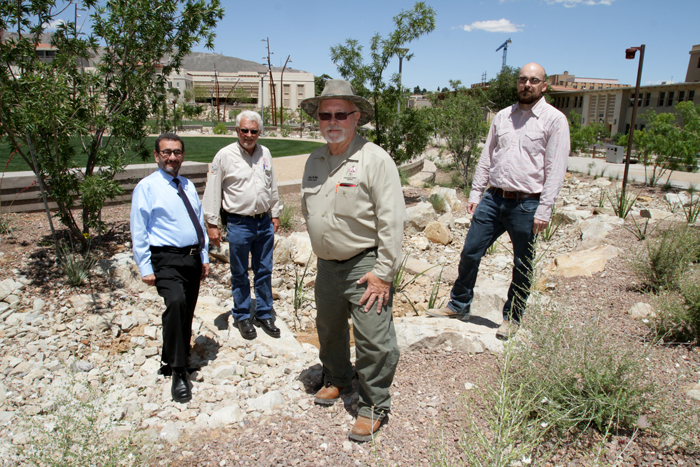Originally published May 22, 2015
By Daniel Perez
UTEP News Service
With the sounds of bird chirps, train whistles and leaves rustling in the background, Paul Perez relaxed on the grassy edge of The University of Texas at El Paso’s new Centennial Plaza to close another week as a University recruiter.
Perez said he visits the plaza several times a week to recharge his batteries. The Master of Leadership Studies student who earned his bachelor’s degree in sociology from UTEP in 2012 is not choosy about his destination. It could be next to one of the gurgling water fountains, a fledgling shade tree or near the lhakhang cultural exhibit. They each provide a sense of peace and quiet.
“It all came together well,” Perez said about the plaza, a legacy project from the institution’s recently completed Centennial Celebration. “I see it as a beautiful gift from the University.”

Much of the plaza’s beauty comes from the selection of native trees and drought-resistant vegetation that were part of a landscaping master plan that was years in the making. Creators of UTEP’s Landscape Architectural Design Standards said the document will benefit the University and landscape developers throughout the Chihuahuan Desert, which straddles approximately 175,000 square miles across the U.S.-Mexico border.
The 80 shade trees, 300 shrubs and vines, and 40 or so grasses were selected because of their splendor and ability to thrive in an area where the climate swings from blistering hot to bitterly cold, and because they help the University achieve its goals of strong campus identity, human comfort, ecological urbanism and sustainability.
Nestor Infanzon, UTEP’s director of Planning and Construction, described how the vegetation was planted strategically, especially within arroyos and acequia water channels, to slow the flow of rainwater to where it replenishes the aquifer.
Infanzon said University President Diana Natalicio was “adamant that we become better stewards of our water resources.” He added that the document nicknamed the “landscape bible” incorporates strategies for lighting, signs, pathways, amenities and more. “Now we will have a comprehensive and cohesive landscaping look that makes our exteriors as attractive and as exciting as our buildings.”
Infanzon said the University’s landscape plan has received informal interest from local entities such as the City of El Paso, and has been presented at a conference of the Society of College and University Planners. He said officials with the U.S. Green Building Council also are aware of it.
Nicole Ferrini, chief resilience officer with the City of El Paso, said Centennial Plaza was impressive in its use of native vegetation and its comprehensive water management strategy.
“Centennial Plaza is now the model for how to achieve the perfect balance between form and function in El Paso,” said Ferrini, whose background is in sustainable architecture and design. “Its approach to resource conservation sets the example for how to survive, adapt and thrive in the face of ongoing climatic challenges, and do it beautifully.”
The landscape standards developers credited UTEP’s Chihuahuan Desert Gardens for laying the foundation for the landscape document. He said the 16-year-old gardens located outside the Centennial Museum served as a lab to study which plant species work on campus.
John White, the garden’s curator, said it was exciting to see the broad use of native plant materials around the plaza because it gave the campus a fresh, natural look that will be sustainable and low maintenance.
During a break inside the museum, he quickly produced a multipage document from 2012 that listed native and adapted trees, shrubs, vines, grasses, perennials, groundcovers and succulents according to their biological and common names.
“This is just the tip of the iceberg,” White said about the plaza’s use of natural vegetation. “This is going to generate a new way of doing things in El Paso.”
The plant palette of trees, flowering plants and ground cover used for the Campus Transformation were modeled after the gardens, said Christine Ten Eyck, president of Austin, Texas-based Ten Eyck Landscape Architects Inc. The University hired the nationally recognized company in fall 2012 to help with UTEP’s ambitious transformation project, which included work on the comprehensive landscape document.
Ten Eyck credited White and Wynn Anderson, a former longtime UTEP administrator who was the garden’s first botanical curator, for their initial efforts to create the landscape standards. Her team expanded the plan from plants and trees to involve the lighting, pathways, fencing, bridges and amenities such as the fire pits and decorative water fountains.
“We take the best elements and weave them together,” Ten Eyck said.
The final product is a campus oasis, said Julian Casillas, a University recruiter who earned his bachelor’s in organizational and corporate communication in 2012. He comes with colleagues to relax and talk shop during the day or with friends after the sun goes down.
“This is a place where you can decompress,” he said. “Come after the sun goes down and the lighting is beautiful.”
To read the landscape document, click on UTEP Landscape Design Standards 2015.